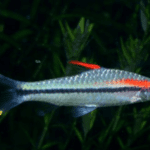Prehistoric-looking dinosaur bichirs rank as one of the most intriguing yet challenging fish species kept by advanced aquarists. From housing considerations to their carnivorous appetites, keeping these unique fish healthy poses specific needs.
Aquarium Size
Providing ample territory remains imperative to curb aggression towards tankmates.
75 Gallon Minimum
A single fully grown dinosaur bichir requires at least a 75 gallon aquarium, with 100+ gallons preferable for their immense 18-24 inch lengths.
Suitable Tankmates
Select appropriate tankmates able to hold their own without getting bullied.
Large Robust Species
Target similarly sized giant fish tankmates that won’t get intimidated easily such as large cichlids, plecos, nurse sharks or stingrays. Smaller specimens inevitably get treated as expensive live food.
Bottom Dwellers
Their lumbering nature makes dinosaur bichirs compatible primarily with bottom oriented tankmates given the possibility of accidentally getting landed upon or crushed by these dinosaurs. Keep open swimming spaces clear for their torpedo-like swimming style.
Tank Setup and Decorations
Cater aquarium layouts to natural environments with the following:
Fine Sand Substrates
Bare-bottom tanks cause stress. Provide ultra fine, silica sand substrates instead to mimic native Niger River basins while preventing potential skin abrasions from coarser gravel types against their scaleless skin.
Driftwood Structures and Plants
Incorporate driftwood branches, rock overhangs and hardy, sturdy plants to provide shaded hiding and resting areas. Planted setups make them feel more secure. Avoid sharp decor.
Low Lighting
Dim lighting following dawn-dusk cycles makes dinosaur bichirs most comfortable in aquariums. Moonlight LEDs can supplement daytime bulbs post-evenings. Excess brightness stresses nocturnal dinosaur bichirs.
Water Parameters and Filtration
Ideal water conditions should follow parameters below:
Temperature Range
Maintain water temperatures between 77-82°F. Dinosaur bichirs thrive in warmer tropical setups. Use aquarium heaters specially designed for larger tanks to keep stable temperatures.
pH Levels
Aim for a maintained pH level around 6.5-7.2. More acidic soft water supplements mimics native African environments better. Alkaline water makes them prone to fungal issues.
Strong Filtration
These messy aquatic predators produce substantial waste. Use heavy-duty external canister filters designed for setups much larger than actual tank sizes to prevent dangerous ammonia and nitrite accumulations their sensitive gills detect.
Conclusion
Though demanding, providing dinosaur bichirs spacious setups, appropriate tankmates, dimly lit structured environments, tropical water conditions and robust filtration enables successfully keeping healthy “living fossils” that never cease captivating fishkeepers!
FAQs About Dinosaur Bichir Care
1. How often should you feed dinosaur bichirs?
Offer adults a varied carnivore diet including pellets, frozen and freeze dried fare 2-3 times per week. Overfeeding risks fatty liver disease and bacterium accumulations in these primitive fish.
2. Can you keep dinosaur bichirs with cichlids?
Yes, large robust African and South American cichlids make excellent dinosaur bichir tankmates provided enough space exists decreasing territorial aggressions. Avoid mixing with small or docile species prone to predation or bullying though.
3. Do dinosaur bichirs need air pumps?
No supplemental air pumps prove necessary provided adequate surface movement. Their primary breathing organ comprises a dual-purpose swim bladder allowing gulping atmospheric oxygen. Strong filters facilitate needed water agitation.
4. Can I handle my dinosaur bichir?
Yes, but always support their entire body to prevent injurious falling and use wet hands or nets to avoid damaging their protective mucous coating. Remain cautious of sharp dorsal and pectoral fin spines as anchoring sensory organs too.
5. What temperature do dinosaur bichirs need?
Dinosaur bichirs thrive in warmer tropical setups between 77-84°F mimicking native African river basins. Temperatures dipping below 75°F make them susceptible to disease and appetite loss from cold stress. Use heaters to maintain stable suitable temps.






I found your blog web site on google and check a number of of your early posts. Proceed to maintain up the excellent operate. I just further up your RSS feed to my MSN News Reader. Looking for ahead to studying more from you later on!…